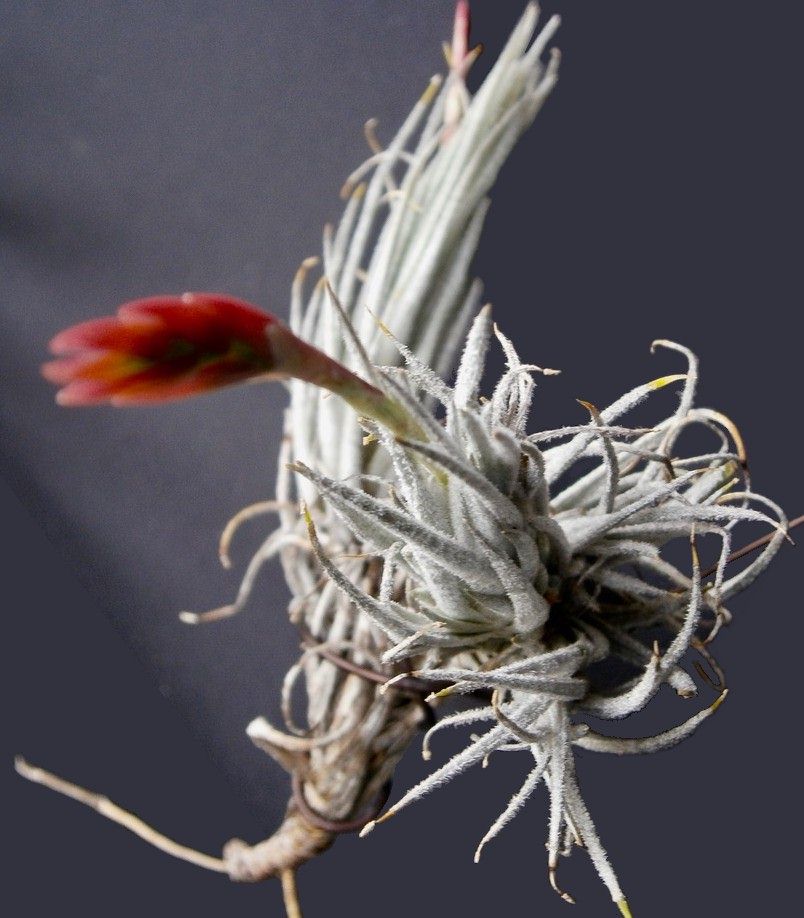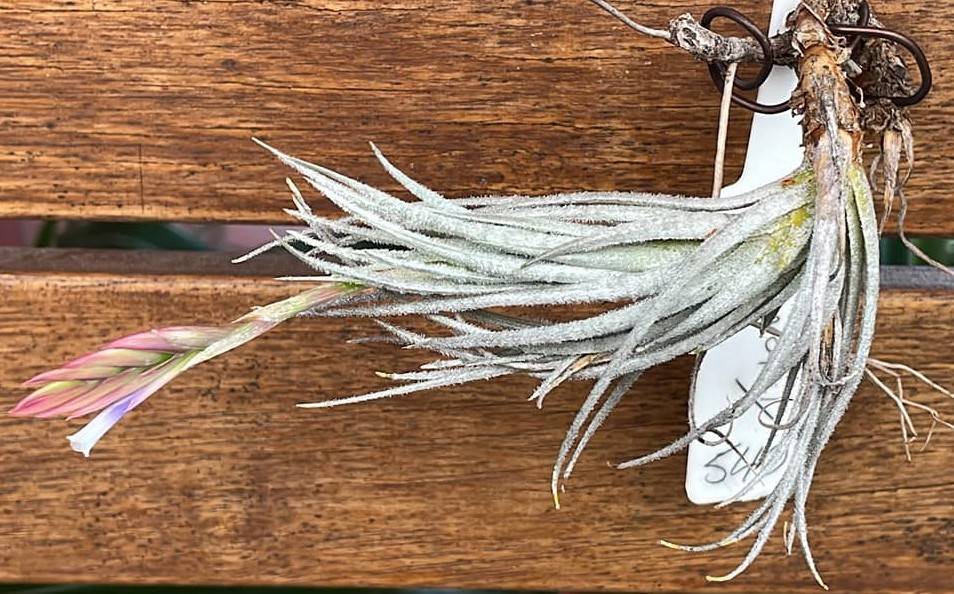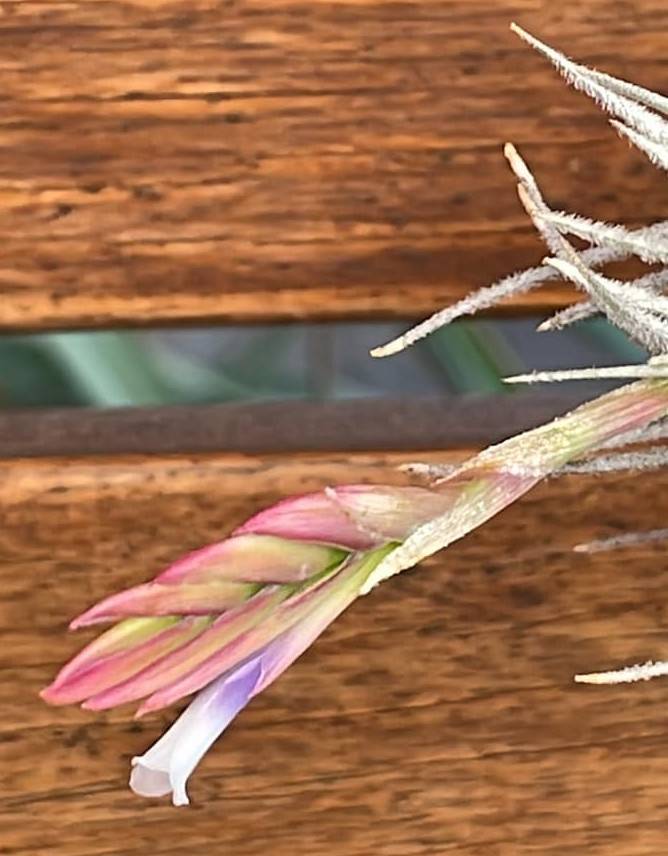


Ray Clark 04/17 ... "following comments in this forum about a plant that was quite rare in collections, almost as rare tomeckii........
I thought that I would get a photo out there before I find another cooked flower spike. The photo isnít a great one, I had some trouble with the light and had to tinker with the image to get it at least viewable, canít wait to see the final throws of flowering."
Len Colgan ... "Congratulations on flowering T. tomekii which I gather came from Derek.
I lost the first two plants of that species that I obtained from Lotte Hromadnik, but a third one has been growing happily for many years. However, it is yet to flower.
You might be interested to know (but probably already do) that in the 2005 description of this species by Lotte and her husband Helmut, it finishes with: "This new species was named after Chief Inspector Rudolf Tomek, who put reason before bureaucracy in favour of species conservation.", so we can be thankful that this species isn't already extinct."
Plant short caulescent, growing lithophytic in small clusters, very narrowly rosulate and conically tapering to the top; flowering to 12 (-17) cm high.
Leaves densely rosulate, imbricate and erect, to 12 cm long, mostly arranged in 4-5 distinct rows, converging and distorted above, the tips spreading;
sheaths triangular, 15 mm wide, chartaceous at base and lower half glabrous adaxially, lepidote outside, merging into the blades;
blades 6 mm wide and very narrowly triangular, soft, channeled, tapering to a fine tip, covered with very narrow eccentric spreading scales.
Scape to 4 cm long, 2 mm wide, glabrous;
scape-bracts densely imbricate, but a part of the scape is visible, sheaths 15 mm long, strongly nerved, papery in a dry state, the lower half glabrous, the upper dense with prominent scales; the lower scape bracts with long leafed blade, the upper ones tipped.
Inflorescence shorter than the leaves, simple or digitate from two sessile erect spikes;
primary bracts much shorter than the spikes, chartaceous, nerved, inside glabrous, outside towards the apex densely lepidote, rose;
spikes sessile, strongly complanate, 25 mm long, 12 mm wide, 3-5-flowered with 2 smaller sterile bracts near the base;
rhachis slender, green, glabrous, geniculate, somewhat flat edges, part visible, internodes 6-4 mm;
floral bracts densely imbricate at base, the tips somewhat spreading, 15 mm long, 6 mm wide, acute-ovoid, carinate, strongly nerved, both sides glabrous, thin, lustrous, bright red;
flowers 21 mm long, subsessile, erect;
sepals 15 mm long, 3 mm wide, sharply lanceolate, equally 3 mm connate, thin, coriaceous only towards the base, both sides glabrous, faintly nerved, the posterior alate-carinate, upper 2/3 bright red, yellowish-green below;
petals 18 mm long, tubular-erect, spatulate, 2 mm wide at base, violet, plate 4 mm wide and elliptic, the rounded tip white and slightly recurved; changing to pale violet after anthesis;
stamens 15 mm long, filaments white, slenderly filiform, straight; anthers pale brown, subbasifixed, 2 mm long, pollen beige; style somewhat longer than the stamens and visible in the flower tube, 16 mm long,
ovary ovate, rounded 3-angled in cross section, pale yellowish green;
style white, slender;
stigma very small, the hardly visible lobes yellowish, spreading, type I following Brown & Gilmartin.
Habitat and range: Up to now, T. tomekii is known from the type locality only, where it grows on vertical rock walls just below 2400 m altitude. T. heteromorpha var. heteromorpha is found above this elevation, to about 3000 m altitude. Populations of a large, short-caulescent form of T. tectorum var. tectorum are also found in the surrounding steep hillsides, together with T. mima var. chiletensis Rauh, which had only been previously found in the Department of Cajamarca. This new species shares the valley system of Rio Maranon with T. chusgonensis, but, in contrast to the latter, comes from the more southern province of Ancash.
In this valley, the following Tillandsia and Racinaea species are still located upstream at elevations up to 3300 m: a small, very compact form of T. cacticola L.B. Sm., the only known location where this species grows on rocks, the normally epiphytic T. aurea Mez, T. capillaris Ruiz & Pav., as well as Racinaea pallidoflavens (Mez) M.A. Spencer & L.B. Sm.
T. tomekii differs from all other known Tillandsia species in this multifaceted group by virtue of its narrow, soft, tomentose-scaled leaves that are arranged in parastiches and form a conically upward-tapering rosette. In individual cases, the plants of the previous flowering retain their leaves, so that up to 30 cm long stems can be formed (HR 23156).
Admittedly, the leaves remind one of T. tectorum, but the floral arrangement of T. tomekii puts it closer to T. heteromorpha. It differs from the latter in the almost lacking-to-short stem, that never reaches or surpasses the length of the leaves, which are soft and tomentose-scaled; the spike is much wider because of the erect flowers, the floral bracts are glabrous and, like the sepals, somewhat longer than in T. heteromorpha, and the sepals are thin, nerved and more connate.
This species differs from T. tectorum in the essentially smaller size of the flowering plant, the very narrow rosette with the upright, 4-5 rows of leaves, the simple or only double-spiked inflorescence, the lax spikes, and the longer and equally high connate glabrous sepals.
This new species was named after Chief Inspector Rudolf Tomek, who put reason before bureaucracy in favour of species conservation.